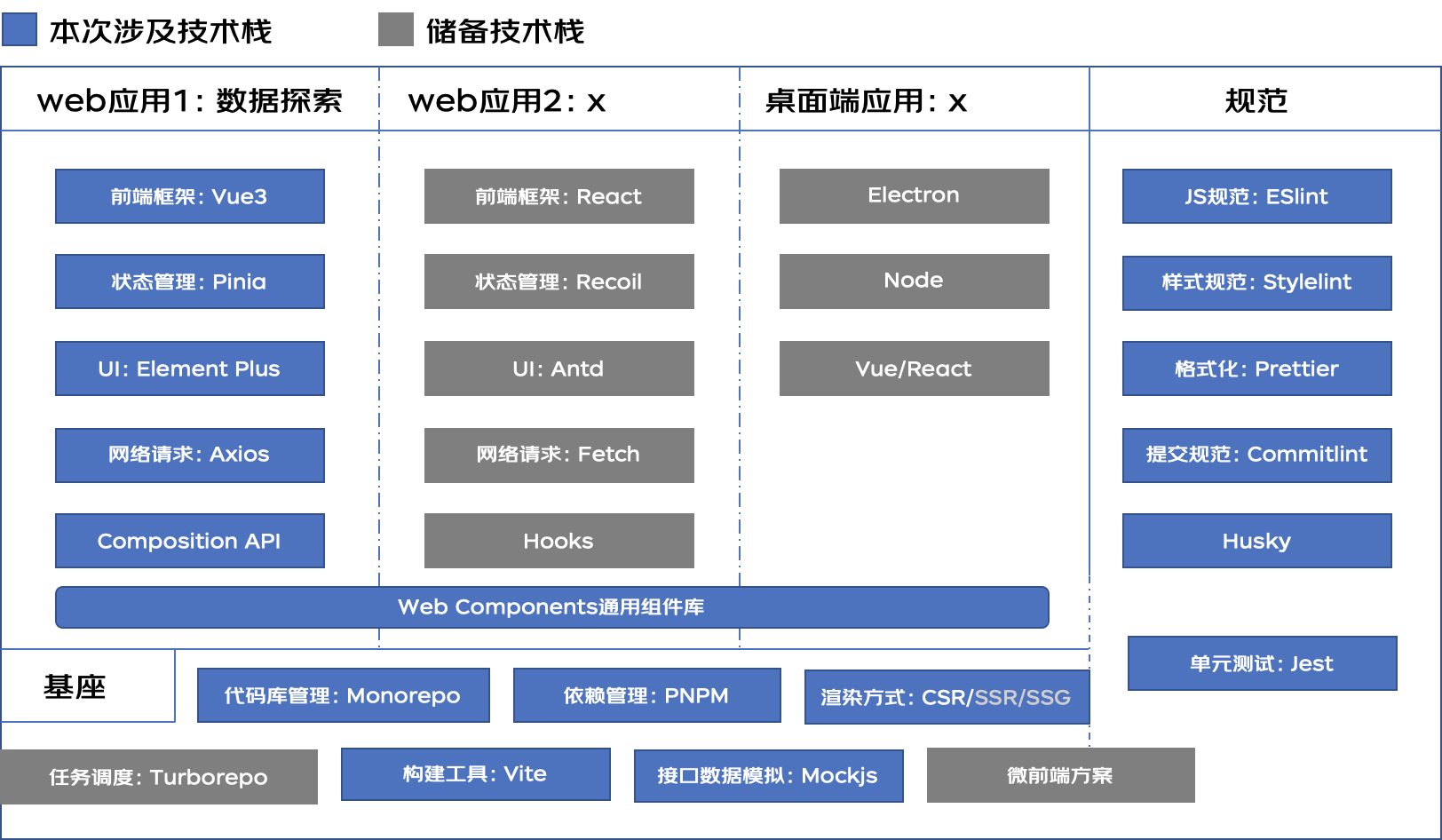一、技术栈选择
1.代码库管理方式-Monorepo: 将多个项目存放在同一个代码库中
▪选择理由 1:多个应用(可以按业务线产品粒度划分)在同一个 repo 管理,便于统一管理代码规范、共享工作流
▪选择理由 2:解决跨项目/应用之间物理层面的代码复用,不用通过发布/安装 npm 包解决共享问题
2.依赖管理-PNPM: 消除依赖提升、规范拓扑结构
▪选择理由 1:通过软/硬链接方式,最大程度节省磁盘空间
▪选择理由 2:解决幽灵依赖问题,管理更清晰
3.构建工具-Vite:基于 ESM 和 Rollup 的构建工具
▪选择理由:省去本地开发时的编译过程,提升本地开发效率
4.前端框架-Vue3:Composition API
▪选择理由:除了组件复用之外,还可以复用一些共同的逻辑状态,比如请求接口 loading 与结果的逻辑
5.模拟接口返回数据-Mockjs
▪选择理由:前后端统一了数据结构后,即可分离开发,降低前端开发依赖,缩短开发周期
二、目录结构设计:重点关注 src 部分
1.常规/简单模式:根据文件功能类型集中管理
mesh-fe├── .husky #git 提交代码触发│ ├── commit-msg
│ └── pre-commit
├── mesh-server #依赖的 node 服务│ ├── mock
│ │ └── data-service #mock 接口返回结果│ └── package.json├── README.md├── package.json├── pnpm-workspace.yaml #PNPM 工作空间├── .eslintignore #排除 eslint 检查├── .eslintrc.js #eslint 配置├── .gitignore├── .stylelintignore #排除 stylelint 检查├── stylelint.config.js #style 样式规范├── commitlint.config.js #git 提交信息规范├── prettier.config.js #格式化配置├── index.html #入口页面└── mesh-client #不同的 web 应用 package├── vite-vue3├── src├── api #api 调用接口层├── assets #静态资源相关├── components #公共组件├── config #公共配置,如字典/枚举等├── hooks #逻辑复用├── layout #router 中使用的父布局组件├── router #路由配置├── stores #pinia 全局状态管理├── types #ts 类型声明├── utils│ ├── index.ts
│ └── request.js #Axios 接口请求封装├── views #主要页面├── main.ts #js 入口└── App.vue
2.基于 domain 领域模式:根据业务模块集中管理
mesh-fe├── .husky #git 提交代码触发│ ├── commit-msg
│ └── pre-commit
├── mesh-server #依赖的 node 服务│ ├── mock
│ │ └── data-service #mock 接口返回结果│ └── package.json├── README.md├── package.json├── pnpm-workspace.yaml #PNPM 工作空间├── .eslintignore #排除 eslint 检查├── .eslintrc.js #eslint 配置├── .gitignore├── .stylelintignore #排除 stylelint 检查├── stylelint.config.js #style 样式规范├── commitlint.config.js #git 提交信息规范├── prettier.config.js #格式化配置├── index.html #入口页面└── mesh-client #不同的 web 应用 package├── vite-vue3├── src #按业务领域划分├── assets #静态资源相关├── components #公共组件├── domain #领域│ ├── config.ts│ ├── service.ts│ ├── store.ts
│ ├── type.ts
├── hooks #逻辑复用├── layout #router 中使用的父布局组件├── router #路由配置├── utils│ ├── index.ts
│ └── request.js #Axios 接口请求封装├── views #主要页面├── main.ts #js 入口└── App.vue
可以根据具体业务场景,选择以上 2 种方式其中之一。
三、搭建部分细节
1.Monorepo+PNPM 集中管理多个应用(workspace)
▪根目录创建 pnpm-workspace.yaml,mesh-client 文件夹下每个应用都是一个 package,之间可以相互添加本地依赖:pnpm install <name>
packages: # all packages in direct subdirs of packages/ - 'mesh-client/*' # exclude packages that are inside test directories - '!**/test/**'
复制代码
▪pnpm install #安装所有package中的依赖
▪pnpm install -w axios #将axios库安装到根目录
▪pnpm --filter | -F <name> <command> #执行某个package下的命令
▪与 NPM 安装的一些区别:
▪所有依赖都会安装到根目录 node_modules/.pnpm 下;
▪package 中 packages.json 中下不会显示幽灵依赖(比如 tslib@types/webpack-dev),需要显式安装,否则报错
▪安装的包首先会从当前 workspace 中查找,如果有存在则 node_modules 创建软连接指向本地 workspace
▪"mock": "workspace:^1.0.0"
2.Vue3 请求接口相关封装
▪request.ts 封装:主要是对接口请求和返回做拦截处理,重写 get/post 方法支持泛型
import axios, { AxiosError } from 'axios'import type { AxiosRequestConfig, AxiosResponse } from 'axios'
// 创建 axios 实例const service = axios.create({ baseURL: import.meta.env.VITE_APP_BASE_URL, timeout: 1000 * 60 * 5, // 请求超时时间 headers: { 'Content-Type': 'application/json;charset=UTF-8' },})
const toLogin = (sso: string) => { const cur = window.location.href const url = `${sso}${encodeURIComponent(cur)}` window.location.href = url}
// 服务器状态码错误处理const handleError = (error: AxiosError) => { if (error.response) { switch (error.response.status) { case 401: // todo toLogin(import.meta.env.VITE_APP_SSO) break // case 404: // router.push('/404') // break // case 500: // router.push('/500') // break default: break } } return Promise.reject(error)}
// request interceptorservice.interceptors.request.use((config) => { const token = '' if (token) { config.headers!['Access-Token'] = token // 让每个请求携带自定义 token 请根据实际情况自行修改 } return config}, handleError)
// response interceptorservice.interceptors.response.use((response: AxiosResponse<ResponseData>) => { const { code } = response.data if (code === '10000') { toLogin(import.meta.env.VITE_APP_SSO) } else if (code !== '00000') { // 抛出错误信息,页面处理 return Promise.reject(response.data) } // 返回正确数据 return Promise.resolve(response) // return response}, handleError)
// 后端返回数据结构泛型,根据实际项目调整interface ResponseData<T = unknown> { code: string message: string result: T}
export const httpGet = async <T, D = any>(url: string, config?: AxiosRequestConfig<D>) => { return service.get<ResponseData<T>>(url, config).then((res) => res.data)}
export const httpPost = async <T, D = any>( url: string, data?: D, config?: AxiosRequestConfig<D>,) => { return service.post<ResponseData<T>>(url, data, config).then((res) => res.data)}
export { service as axios }
export type { ResponseData }
复制代码
▪useRequest.ts 封装:基于 vue3 Composition API,将请求参数、状态以及结果等逻辑封装复用
import { ref } from 'vue'import type { Ref } from 'vue'import { ElMessage } from 'element-plus'import type { ResponseData } from '@/utils/request'export const useRequest = <T, P = any>( api: (...args: P[]) => Promise<ResponseData<T>>, defaultParams?: P,) => { const params = ref<P>() as Ref<P> if (defaultParams) { params.value = { ...defaultParams, } } const loading = ref(false) const result = ref<T>() const fetchResource = async (...args: P[]) => { loading.value = true return api(...args) .then((res) => { if (!res?.result) return result.value = res.result }) .catch((err) => { result.value = undefined ElMessage({ message: typeof err === 'string' ? err : err?.message || 'error', type: 'error', offset: 80, }) }) .finally(() => { loading.value = false }) } return { params, loading, result, fetchResource, }}
复制代码
▪API 接口层
import { httpGet } from '@/utils/request'
const API = { getLoginUserInfo: '/userInfo/getLoginUserInfo',}type UserInfo = { userName: string realName: string}export const getLoginUserInfoAPI = () => httpGet<UserInfo>(API.getLoginUserInfo)
复制代码
▪页面使用:接口返回结果 userInfo,可以自动推断出 UserInfo 类型,
// 方式一:推荐const { loading, result: userInfo, fetchResource: getLoginUserInfo,} = useRequest(getLoginUserInfoAPI)
// 方式二:不推荐,每次使用接口时都需要重复定义typetype UserInfo = { userName: string realName: string}const { loading, result: userInfo, fetchResource: getLoginUserInfo,} = useRequest<UserInfo>(getLoginUserInfoAPI)
onMounted(async () => { await getLoginUserInfo() if (!userInfo.value) return const user = useUserStore() user.$patch({ userName: userInfo.value.userName, realName: userInfo.value.realName, })})
复制代码
3.Mockjs 模拟后端接口返回数据
import Mock from 'mockjs'const BASE_URL = '/api'Mock.mock(`${BASE_URL}/user/list`, { code: '00000', message: '成功', 'result|10-20': [ { uuid: '@guid', name: '@name', tag: '@title', age: '@integer(18, 35)', modifiedTime: '@datetime', status: '@cword("01")', }, ],})
复制代码
四、统一规范
1.ESLint
注意:不同框架下,所需要的 preset 或 plugin 不同,建议将公共部分提取并配置在根目录中,package 中的 eslint 配置设置 extends。
/* eslint-env node */require('@rushstack/eslint-patch/modern-module-resolution')
module.exports = { root: true, extends: [ 'plugin:vue/vue3-essential', 'eslint:recommended', '@vue/eslint-config-typescript', '@vue/eslint-config-prettier', ], overrides: [ { files: ['cypress/e2e/**.{cy,spec}.{js,ts,jsx,tsx}'], extends: ['plugin:cypress/recommended'], }, ], parserOptions: { ecmaVersion: 'latest', }, rules: { 'vue/no-deprecated-slot-attribute': 'off', },}
复制代码
2.StyleLint
module.exports = { extends: ['stylelint-config-standard', 'stylelint-config-prettier'], plugins: ['stylelint-order'], customSyntax: 'postcss-html', rules: { indentation: 2, //4空格 'selector-class-pattern': '^(?:(?:o|c|u|t|s|is|has|_|js|qa)-)?[a-zA-Z0-9]+(?:-[a-zA-Z0-9]+)*(?:__[a-zA-Z0-9]+(?:-[a-zA-Z0-9]+)*)?(?:--[a-zA-Z0-9]+(?:-[a-zA-Z0-9]+)*)?(?:\[.+\])?$', // at-rule-no-unknown: 屏蔽一些scss等语法检查 'at-rule-no-unknown': [true, { ignoreAtRules: ['mixin', 'extend', 'content', 'export'] }], // css-next :global 'selector-pseudo-class-no-unknown': [ true, { ignorePseudoClasses: ['global', 'deep'], }, ], 'order/order': ['custom-properties', 'declarations'], 'order/properties-alphabetical-order': true, },}
复制代码
3.Prettier
module.exports = { printWidth: 100, singleQuote: true, trailingComma: 'all', bracketSpacing: true, jsxBracketSameLine: false, tabWidth: 2, semi: false,}
复制代码
4.CommitLint
module.exports = { extends: ['@commitlint/config-conventional'], rules: { 'type-enum': [ 2, 'always', ['build', 'feat', 'fix', 'docs', 'style', 'refactor', 'test', 'chore', 'revert'], ], 'subject-full-stop': [0, 'never'], 'subject-case': [0, 'never'], },}
复制代码
五、附录:技术栈图谱
作者:京东科技 牛志伟
来源:京东云开发者社区














评论